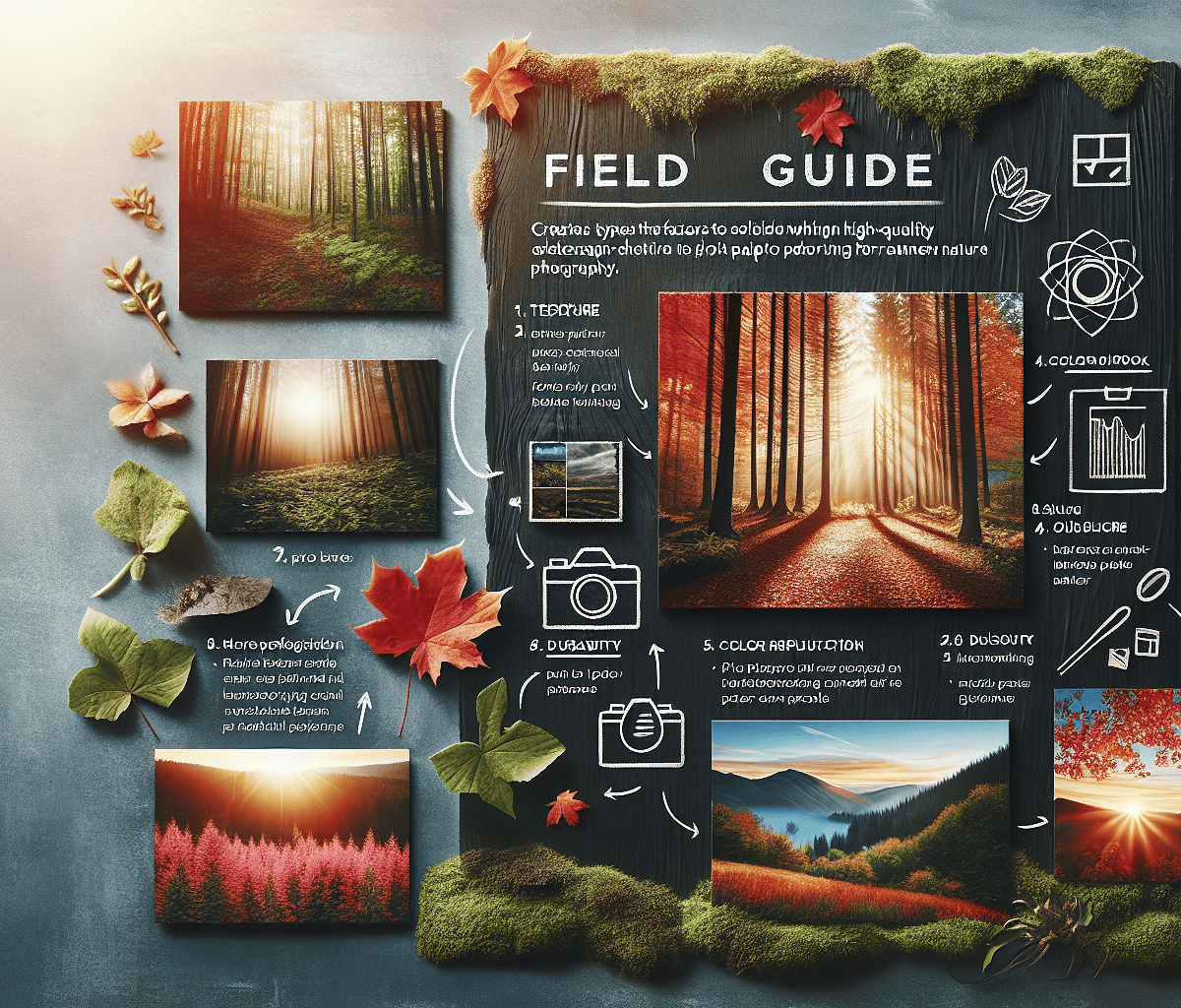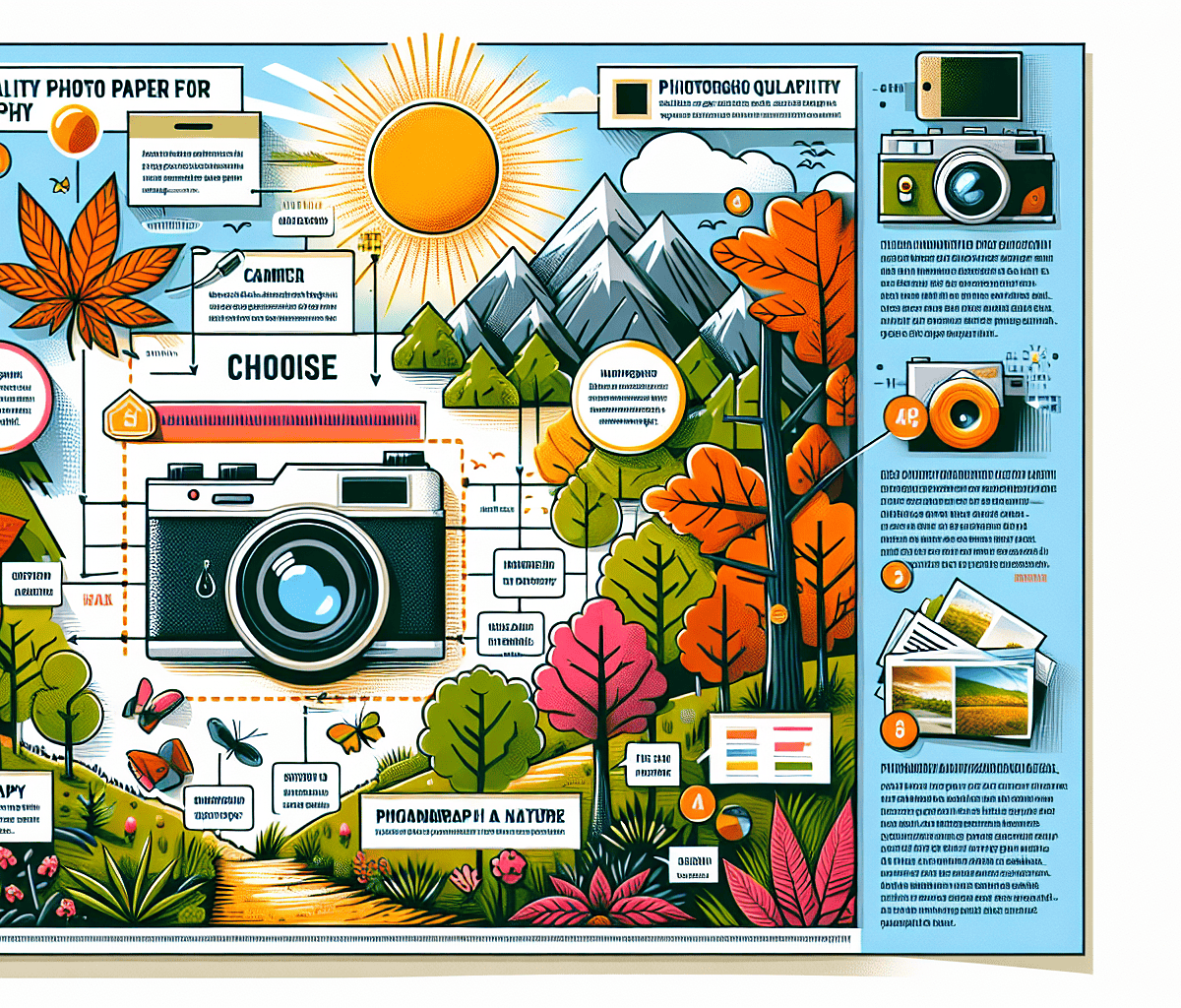Understanding the Key Features of Photo Paper
When it comes to enhancing photos, choosing photo paper is an essential step. Aware of the issues, whether for internal needs or customer presentations, a company like yours must opt for photo paper offering the best possible reproduction. Let’s examine together the different criteria that will guide your choice towards excellence in photographic printing.
Weight and thickness: the guarantors of quality
THE weight, expressed in grams per square meter (g/m²), is a first indication of the quality of the paper. Higher weight often means better fit and a luxurious feel to the touch. By opting for thick paper, not only do you ensure increased durability of your prints, but you also convey an image of seriousness and professionalism.
Texture: touch serving the eye
The texture of photo paper is an essential element that contributes to the visual experience. Smooth, satin or with a pronounced grain, each texture brings its own character to the image. A glossy paper will tend to intensify the colors and provide a delicate “mirror” effect, perfect for vivid, detailed photos. On the other hand, a matte paper is ideal for avoiding annoying reflections and admirably enhances subtle nuances.
Color rendering: fidelity and vibrancy
Testing color rendering is crucial. A company cannot afford prints where the colors deviate from their original intention. A good photo paper should provide excellent color space allowing faithful reproduction of the captured hues. For high quality prints, choose photo paper with good color range and a high contrast.
Resistance to degradation: durability of prints
The durability of your photo prints is a significant criterion. For a business, each document must stand the test of time. It is therefore essential to select a paper that does not yellow and is resistant to degrading agents, such as UV or humidity. Papers treated against these elements will guarantee optimal preservation of your documents.
Printer Compatibility: Ensure smooth printing
No detail should be left to chance, including the compatibility of the paper with your printing equipment. Each printer has its specificities and it is essential that the paper chosen corresponds to its technical criteria to avoid any technical problems and guarantee consistent printing quality.
In short, the choice of photo paper is essential to enhance the photographic work and reflect the professionalism of your business. Take these criteria into account – weight, texture, color rendering, resistance and compatibility – for a photo print that meets your expectations. It is an investment that projects the brand image of your company and the excellence of your services or products.
Take the time to speak with reputable suppliers, review samples, and don’t hesitate to seek advice on a suitable photo printing solution, tailored to your printer and your professional ambitions. Quality paper makes all the difference, it is the link between a beautiful photograph and a work of art that captures attention, arouses emotion and tells a story.
Criteria for selecting high quality photo paper

Weight: A Weight Factor
When we talk about quality in photo papers, one of the first criteria that jumps out at you is the weight. This term indicates the density of the paper, expressed in grams per square meter (g/m²). Thicker, denser paper often conveys a feeling of luxury and durability, not to mention that it is less prone to curling and allows for better color retention. Ideally, high-quality photo paper should be of significant weight, providing a solid foundation for long-lasting prints.
The Finish: Brilliance and Precision
A suitable finish can enhance a photograph. Here, we have several options: glossy, matte, satin, or even textured. Each finish has its own impact on the final visual appearance. The finish brilliant is prized for its brightness and liveliness, highlighting vibrant colors and contrast. The finish matte, for its part, is often chosen for its absence of reflection, offering better readability under various light sources. The intermediate satin finish offers a good compromise between the two. While textured papers offer an additional artistic dimension to your work. The key is to select the type of finish that will best highlight the nature and style of your images.
Print Compatibility: Guidelines and Results
Another crucial aspect is the compatibility of the paper with your printing equipment. Before purchasing, be sure to check that the paper is compatible with your specific printer model. While some papers are universal, others are optimized for certain brands or technologies, whether inkjet or dye-sublimation printers. Good compatibility not only ensures a smooth printing process but also optimal image quality.
Longevity: Resistance to Time
What about the durability of your prints? It is essential to choose photo paper treated to resist yellowing and damage caused by UV rays. Some high-quality photo papers are designed with special coatings that make them more resistant facing light and humidity. This protection ensures your precious prints remain true to their original quality for decades.
The Format: A Question of Dimension
Also consider what size photo paper you need. These come in a plethora of sizes ranging from classic 10×15 formats for instant photos to larger formats for life-size prints. The size of the paper should be selected in accordance with the staging you plan for your photos, whether to display them, encapsulate them in an album or frame them.
By taking these criteria into account, you will be able to choose a photo paper that will not only do justice to your images, but which will preserve them with vibrancy and integrity over the long term. The quality of photo paper is directly linked to the durability and aesthetics of your prints. So take the time to consider weight, finish, print compatibility, longevity and format to make the most informed choice. Good photo paper guarantees a visual legacy that will last through the years with the same intensity as the day it was printed.
The different types of photo paper and their uses

When it comes to bringing your fondest memories to life or showcasing your professional portfolio, the choice of photo paper is as crucial as the quality of your shot. Indeed, each type of paper has its distinct characteristics which will influence not only the aesthetics, but also the durability of your photos. It is important to know them to best bring out the quintessence of your photos.
Glossy paper for vibrant colors and striking contrast, is perfect for landscape photos or portraits where every detail counts. Its smooth, shiny surface attracts the eye and highlights the depth of the colors. With excellent print quality, it is often preferred for photos that will end up framed or exhibited in galleries.
Matte paper, for its part, offers a sober and elegant finish. It is ideal if you are looking to avoid the reflections often generated by lighting on shiny surfaces. Photographers who want to print black and white photos favor this type of paper because it provides unique texture and depth.
On the other hand, satin paper finds its balance between the two previous ones. With a slight sheen, it’s versatile enough for a variety of uses, from family photo albums to business presentations.
For photographers on the lookout for new technologies, you will certainly appreciate the latest instant cameras tested which allow you to print your creations directly on paper with a unique finish. This demonstrates the constant evolution of printing media in parallel with photographic advances.
The importance of choice according to needs
It is essential to consider the environment where the photo will be displayed in order to select the most appropriate paper. For a company like that of Marine, which seeks to optimize its printing processes, the efficiency of choice between a laser or inkjet printer plays a major role in the final quality of the photo paper used.
When it comes to professional presentation, durability is another criterion that should not be overlooked. High quality paper not only adds prestige to your prints but also guarantees optimal preservation over time. Whether for internal communication or visual marketing, choosing the right paper is synonymous with enhancing the message transmitted.
Protection and respect of rights
In a world where images are omnipresent, it is just as crucial to be concerned with questions of copyright and of youth protection when printing photos. It is recommended to use royalty free photos or to ensure that you have obtained the necessary authorizations for any reproduction of images.
Considering modernizing image processing applications can be beneficial, as suggested tips for modernizing legacy applications for the cloud, thus allowing more efficient and secure file management.
Conclusion and recommendations
Knowledge of the different types of photo paper and their uses is a fundamental pillar for any photographer or business that aspires to a high-quality print presentation. Associated with the judicious use of contemporary tools and software, such as the best photo editing apps for Android, you’ll build an aesthetic that best reflects your creative intentions or company values.
Don’t overlook the impact of a good choice of photo paper to convey a professional and memorable image. It’s a subtle but powerful material that gives shape to your visions and tells a story well beyond the pixels.
Practical tips for testing and buying the right photo paper

Choosing the Ideal Paper for Your Photo Prints
There quality of your photographic prints depends largely on the choice of paper. A wise choice gives your images vibrant colors, precise details and remarkable durability. But how to select the best support from this vast array? Follow these tips to avoid making a mistake.
Analyze your Rendering Needs
Before you start buying, ask yourself the right questions. What is the end goal of your printing? Is it for an album marriage refined or for a professional photo exhibition? The nature of your photos will dictate your choice of paper. For prints worthy of an art gallery, choose a high-end matte paper with a delicate finish and rich in details. If you are looking to make a lively and sparkling album, a glossy photo paper will be more appropriate to bring out the vibrancy of the colors.
Test Different Papers Before Purchasing
It is crucial to test the paper before committing to a large quantity. Buy samples or small packs to evaluate the results. Many suppliers offer various sample kits. Take the time to inspect each print in different lights; the appearance can change significantly from natural to artificial light.
Compare Formats and Weights
Paper weight, expressed in grams per square meter (g/m²), is an indicator of the density and quality of the paper. Papers more heavy provide a feeling of luxury and are often more durable. However, make sure your printer can handle the weight you choose. Additionally, think about the ideal format for your prints. From the classic 10×15 cm to the large A3 format, each choice must be adapted to the intended use.
Consider Plexi or Aluminum Printing
For a truly spectacular finish, why not consider printing on plexiglass or aluminum? This gives a touch of modernity and unparalleled depth to the photos. Online comparisons can help you determine if printing on rigid media is the best choice for your project.
Learn about Sustainability and Conservation
Preserving your photo prints is a major concern. Good photo paper should resist fading and degradation over time. Look for papers with UV and water-resistant treatments to ensure your images last a long time.
Opt for a Smart and Secure Purchase
In a world where online scams are rife, make sure you buy your paper from trusted sites. Look for recent customer reviews or expert recommendations. And if you are considering new equipment, refer to our selection of the best printers in 2024.
Budget and Value for Money
Mark your budget before choosing your photo paper. Opt for a product offering the best quality/price ratio according to your needs. Don’t hesitate to compare costs per print, and consider purchasing bundles to save money without compromising quality.
By following these tips, you will be able to choose the photo paper ideal, the one that will enhance your images and preserve them for future generations. Acquiring the right paper is an investment in the longevity of your memories and the impact of your works. Be meticulous, and every print will be a source of pride.


Leave a Reply